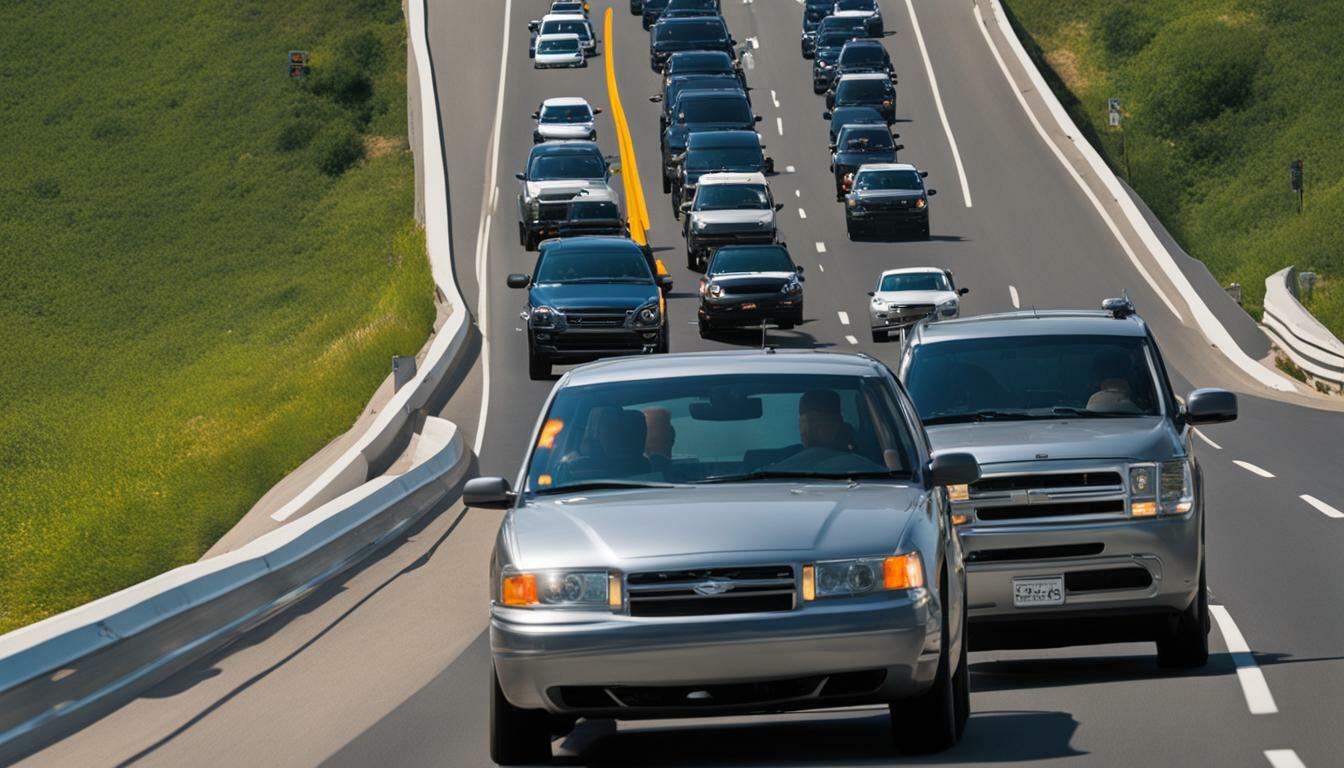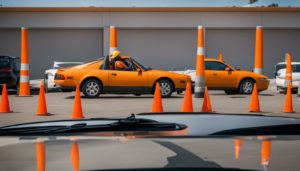Traffic Laws for Rightmost Lane Driving
Driving in the rightmost lane comes with specific traffic laws and regulations that must be followed to ensure road safety.
Key Takeaways:
- In Washington state, it is illegal to continuously drive in the left lane if the road has two or more lanes going in the same direction.
- Washington's law allows driving in the left lane when passing another vehicle, moving faster than other vehicles in right lanes, allowing traffic to merge, or preparing to turn left at an intersection, exit, private driveway, or road.
- Vehicles carrying a towing trailer or with a weight exceeding 10,000 pounds cannot ride in the left lane or a roadway consisting of three lanes or more.
- Most states require drivers to keep right if they are driving slower than the normal speed of traffic, regardless of the speed limit.
- Some states have laws that require drivers to move right if they are blocking traffic in the left lane.
- Enforcement of these laws can vary from state to state.
Understanding Rightmost Lane Driving in Washington State
In Washington state, there are specific laws and legal requirements that govern driving in the rightmost lane. It is essential for drivers to understand these regulations and comply with them to ensure road safety and efficient traffic flow.
According to Washington state law, it is illegal for drivers to continuously travel in the left lane if there are two or more lanes going in the same direction. This law aims to prevent congestion and maintain a smooth flow of traffic. However, it is important to note that the law does not explicitly state that it is illegal to drive in the left lane if driving under the speed limit.
Similar to other states, Washington's law specifies that it is a traffic infraction to drive continuously in the left lane “when it impedes the flow of other traffic.” This means that drivers should use the left lane only for passing another vehicle, moving faster than other vehicles in the right lanes, accommodating traffic merging, or preparing to make a left turn at an intersection, exit, private driveway, or road.
| Exceptions | Restrictions |
|---|---|
| Passing another vehicle | Continuous driving in the left lane |
| Moving faster than other vehicles in right lanes | Impeding the flow of other traffic |
| Accommodating traffic merging | Navigating an intersection, exit, private driveway, or road |
It is worth noting that vehicles carrying a towing trailer or with a weight exceeding 10,000 pounds are not allowed to ride in the left lane or on roadways consisting of three lanes or more. These regulations aim to ensure the safety and proper flow of traffic.
While Washington state has specific laws regarding rightmost lane driving, it is important to remember that most states have similar laws that require drivers to keep right if they are driving slower than the normal speed of traffic. Additionally, some states have laws that require drivers to move right if they are blocking traffic in the left lane. However, enforcement of these laws can vary.
Occupying the Left Lane: Restrictions and Exceptions
While driving in the rightmost lane, there are certain rules and guidelines regarding the occupation of the left lane that must be understood. In Washington state, it is illegal to continuously drive in the left lane if the road has two or more lanes going in the same direction. This law is aimed at promoting the smooth flow of traffic and preventing congestion.
The rules in Washington state state that it is a traffic infraction to drive continuously in the left lane “when it impedes the flow of other traffic.” However, it's important to note that the law does not explicitly state that it is illegal to drive in the left lane if driving under the speed limit. This means that drivers can legally use the left lane to drive at a slower pace, as long as it doesn't impede the flow of other vehicles.
There are also exceptions to the rule. In Washington state, a driver can use the left lane when passing another vehicle, moving faster than other vehicles in the right lanes, allowing traffic to merge, or preparing to turn left at an intersection, exit, private driveway, or road. However, it's important to be aware that vehicles carrying a towing trailer or weighing over 10,000 pounds are not allowed to ride in the left lane or on a roadway consisting of three lanes or more.
| Rules for Occupying the Left Lane | Exceptions |
|---|---|
| Illegal to continuously drive in the left lane on roads with two or more lanes in the same direction | Passing another vehicle |
| Driving under the speed limit is not explicitly illegal | Moving faster than other vehicles in right lanes |
| Traffic infraction to impede the flow of other traffic | Allowing traffic to merge |
| Vehicles carrying a towing trailer or weighing over 10,000 pounds cannot ride in the left lane or on a roadway consisting of three lanes or more | Preparing to turn left at an intersection, exit, private driveway, or road |
It's important to familiarize yourself with the specific rules and exceptions in your state or region, as laws regarding the occupation of the left lane can vary. Understanding and following these rules will help promote safer, more efficient driving and ensure a better flow of traffic for everyone on the road.
State-Specific Laws: Examples and Variations
Each state may have specific regulations and variations when it comes to driving in the rightmost lane, so it's important to be aware of these laws. In Washington state, for example, there are specific restrictions on occupying the left lane while driving in the rightmost lane. According to Washington's traffic laws, it is illegal to continuously drive in the left lane if it impedes the flow of other traffic, but there is no explicit mention of driving under the speed limit.
On the other hand, in states like Maine, it is illegal to occupy the left lane unless passing another vehicle going at least 65 miles per hour. While Washington's law is similar, it is slightly more lenient regarding the speed limit and penalties. The rules in Washington allow for the use of the left lane when passing another vehicle, moving faster than other vehicles in right lanes, allowing traffic to merge, or preparing to turn left at an intersection, exit, private driveway, or road.
It's worth noting that vehicles carrying a towing trailer or with a weight exceeding 10,000 pounds are not allowed to ride in the left lane or on roadways consisting of three lanes or more in Washington state. Additionally, most states have laws that require drivers to keep right if they are driving slower than the normal speed of traffic, regardless of the speed limit. Some states also have laws that require drivers to move right if they are blocking traffic in the left lane. However, the enforcement of these laws can vary.
| State | Occupying Left Lane Restrictions |
|---|---|
| Washington | Cannot continuously drive in the left lane when it impedes the flow of other traffic |
| Maine | Cannot occupy the left lane unless passing another vehicle going at least 65 miles per hour |
| Other states | May have similar laws requiring drivers to keep right if driving slower than the normal speed of traffic or if blocking traffic in the left lane |
In conclusion, understanding the specific regulations and variations regarding driving in the rightmost lane is crucial for all drivers. By familiarizing ourselves with these laws, we can ensure the safety and efficient flow of traffic on our roads.
Enforcement and Penalties
With any traffic laws, enforcement is crucial, and rightmost lane driving laws are no exception. Understanding the penalties for violations is essential for all drivers. In Washington state, the enforcement of rightmost lane driving laws can result in traffic infractions and fines. Continuous driving in the left lane, when it impedes the flow of other traffic, is considered a violation. It is important to note that the law does not explicitly state that driving under the speed limit in the left lane is illegal, but it is still advisable to keep right unless passing to maintain smooth traffic flow.
Penalties for rightmost lane driving violations can vary depending on the state and circumstances. In Washington state, violating the law can result in a traffic infraction with a fine. The amount of the fine is determined by the court and may vary based on factors such as the severity of the violation or prior offenses. It is crucial to be aware of these penalties to avoid potential consequences and maintain a safe driving environment for all.
It is worth noting that enforcement of rightmost lane driving laws can differ from state to state. While Washington state strictly prohibits continuous driving in the left lane, some states like Maine have more specific regulations, such as prohibiting left lane usage unless passing a vehicle traveling at least 65 miles per hour. To ensure compliance with the laws in your specific state, always refer to the local traffic code and consult with local authorities if needed.
Summary of Enforcement and Penalties:
| Violation | Penalty |
|---|---|
| Continuous driving in the left lane impeding traffic flow (Washington state) | Traffic infraction with fine (amount determined by the court) |
Understanding and adhering to rightmost lane driving laws is crucial for all drivers. By following these regulations, we can promote safer and more efficient roadways. Remember to always keep right unless passing, allow traffic to merge, and be mindful of other drivers. Together, we can create a better driving experience for everyone.
Best Practices for Rightmost Lane Driving
To enhance road safety and promote efficient traffic flow, it's important to follow certain tips and guidelines when driving in the rightmost lane. By understanding and adhering to these best practices, you can contribute to a smoother and safer driving experience for everyone on the road.
Here are some helpful tips to keep in mind:
- Keep a consistent speed: When driving in the rightmost lane, it's important to maintain a speed consistent with the flow of traffic. This helps prevent abrupt lane changes and reduces the risk of accidents caused by speed differentials.
- Use signals effectively: Signaling your intentions is crucial in any driving situation, including when using the rightmost lane. Always use your turn signals to indicate lane changes or when exiting the roadway. This allows other drivers to anticipate your actions and adjust their driving accordingly.
- Stay alert and aware: Being vigilant on the road is essential for safe driving. Pay close attention to your surroundings, including other vehicles, pedestrians, and road conditions. Avoid distractions such as using your phone or engaging in other activities that take your focus away from the road.
Remember, the rightmost lane is typically designated for slower-moving vehicles and those preparing to exit the roadway. It's important to be courteous and yield to faster-moving traffic, allowing them to pass on the left as needed.
Additional Guidelines for Rightmost Lane Driving
In addition to the above tips, here are a few more guidelines to ensure safe and effective rightmost lane driving:
- Merge with caution: If you need to merge into the rightmost lane from another lane or an on-ramp, do so carefully and smoothly. Signal your intention, check your blind spots, and yield to any oncoming traffic before merging.
- Be aware of your blind spots: Larger vehicles such as trucks and buses may have larger blind spots, so be extra cautious when sharing the road with them. Avoid lingering in their blind spots and give them ample space when passing or being passed.
- Plan your exits in advance: If you know you will need to exit the roadway soon, start preparing for your exit well in advance. Signal early, check for traffic, and smoothly transition into the appropriate lane to avoid last-minute maneuvers.
By following these best practices and guidelines, you can help create a safer and more efficient driving environment for everyone on the road. Remember to always prioritize safety and be mindful of other drivers, ensuring a smoother and more enjoyable driving experience for all.
| Tip | Guideline |
|---|---|
| Keep a consistent speed | Maintain a speed consistent with traffic flow |
| Use signals effectively | Always signal lane changes and exits |
| Stay alert and aware | Avoid distractions and pay attention to surroundings |
| Merge with caution | Signal, check blind spots, and yield when merging |
| Be aware of blind spots | Give larger vehicles ample space and avoid blind spots |
| Plan exits in advance | Signal early and smoothly transition to the exit lane |
Conclusion
Adhering to traffic laws for rightmost lane driving is essential for road safety and efficient traffic flow. By understanding and following these laws, drivers can contribute to a safer driving experience for all.
In Washington state, it is illegal to continuously drive in the left lane if the road has two or more lanes going in the same direction. While the law does not explicitly state that driving under the speed limit in the left lane is illegal, it is considered a traffic infraction if it impedes the flow of other traffic.
Drivers in Washington can use the left lane for passing other vehicles, moving faster than other vehicles in the right lanes, allowing traffic to merge, or preparing to turn left at an intersection, exit, private driveway, or road. However, vehicles carrying a towing trailer or weighing more than 10,000 pounds are not allowed to ride in the left lane or a roadway consisting of three lanes or more.
It's worth noting that many states have laws requiring drivers to keep right if they are driving slower than the normal speed of traffic, regardless of the speed limit. Some states also have laws that require drivers to move right if they are blocking traffic in the left lane. Enforcement of these laws can vary.
By being aware of and respecting these regulations, drivers can help create a safer and more efficient driving environment. Remember, it's not just about following the rules—it's about ensuring the well-being of all road users.
FAQ
Is it illegal to continuously drive in the left lane in Washington state?
Yes, it is illegal to continuously drive in the left lane in Washington state if it impedes the flow of other traffic.
Are there any exceptions to using the left lane in Washington state?
Yes, there are exceptions to using the left lane in Washington state. You can use the left lane when passing another vehicle, moving faster than other vehicles in right lanes, allowing traffic to merge, or preparing to turn left at an intersection, exit, private driveway, or road. However, vehicles carrying a towing trailer or with a weight exceeding 10,000 pounds cannot ride in the left lane or a roadway consisting of three lanes or more.
Are there similar laws in other states regarding driving in the left lane?
Yes, many states have laws that require drivers to keep right if they are driving slower than the normal speed of traffic, regardless of the speed limit. Some states also have laws that require drivers to move right if they are blocking traffic in the left lane. However, the enforcement of these laws can vary.



